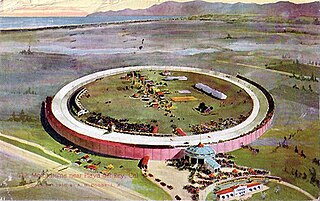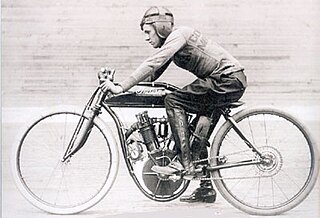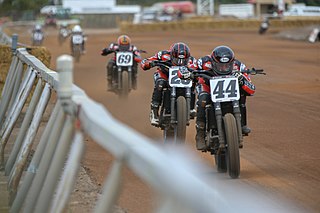
Indian Motorcycle is an American brand of motorcycles owned and produced by American automotive manufacturer Polaris Inc.

Glenn Hammond Curtiss was an American aviation and motorcycling pioneer, and a founder of the U.S. aircraft industry. He began his career as a bicycle racer and builder before moving on to motorcycles. As early as 1904, he began to manufacture engines for airships. In 1908, Curtiss joined the Aerial Experiment Association, a pioneering research group, founded by Alexander Graham Bell at Beinn Bhreagh, Nova Scotia, to build flying machines.
Albert Crocker (1882–1961) was an American inventor and the founder of Crocker Motorcycles. His innovations had a substantial influence on the motorcycle and racing business.
Hawthorne Race Course is a racetrack for horse racing in Stickney, Illinois, near Chicago.
Mert Lawwill is an American professional motorcycle racer, race team owner and mountain bike designer. He competed in the AMA Grand National Championship from 1962 to 1977. Lawwill is notable for winning the 1969 AMA Grand National Championship as a member of the Harley-Davidson factory racing team. After his motorcycle racing career, Lawwill became one of the top motorcycle racing frame designers and builders. Lawwill then used his experience as a motorcycle frame builder to become an innovative mountain bike designer, developing one of the first bicycle suspensions. He also developed prosthetic limbs for amputees. Lawwill was inducted in the Mountain Bike Hall of Fame in 1997 and the Motorcycle Hall of Fame in 1998.

Board track racing was a type of motorsport popular in the United States during the 1910s and 1920s. Competition was conducted on circular or oval race courses with surfaces composed of wooden planks. This type of track was first used for motorcycle competition, wherein they were called motordromes, before being adapted for use by various different types of racing cars. The majority of the American national championship races were contested at such venues during the 1920s.

The Los Angeles Motordrome was a circular 1-mile (1.6 km) wood board race track. It was located in Playa del Rey, California, and opened in 1910. In addition to automobile racing, it was used for motorcycle competition and aviation activities.

Eddie Hasha was an American motorcycle racer on board tracks early in the twentieth century. His death contributed to the demise of the board tracks. He was nicknamed the "Texas Cyclone" since he was from Waco, Texas, United States.
Jacob DeRosier was a Canadian professional motorcycle racer. He was one of the first factory-backed motorcycle racers of the early 20th Century. He rode for Indian and then Excelsior, and was the fastest rider in the United States in the early 1900s.

Oscar Hedstrom was a co-founder of the Indian Motocycle Manufacturing Company.

George Mallory Hendee was a bicycle racer and co-founder of the Indian Motocycle Manufacturing Company. Hendee first became involved with the bicycle industry after his bicycle-racing career. Not only did Hendee build bicycles, but he also sponsored numerous bicycle events and racers. Once he retired from racing and the manufacturing company, Hendee bred cattle and chickens on his farm.

Excelsior Motor Manufacturing & Supply Company was an American motorcycle manufacturer operating in Chicago from 1907 to 1931. It was purchased by Ignaz Schwinn, proprietor of bicycle manufacturer Arnold, Schwinn & Co. in 1912. In 1912, an Excelsior was the first motorcycle to be officially timed at a speed of 100 mph. The Henderson Motorcycle Company became a division of Excelsior when Schwinn purchased Henderson in 1917. By 1928, Excelsior was in third place in the U.S. motorcycle market behind Indian and Harley-Davidson. The Great Depression convinced Schwinn to order Excelsior's operations to cease in September 1931.

American Flat Track is an American motorcycle racing series. The racing series, founded and sanctioned by the American Motorcyclist Association (AMA) in 1954, originally encompassed five distinct forms of competitions including mile dirt track races, half-mile, short-track, TT steeplechase and road races. The championship was the premier motorcycle racing series in the United States from the 1950s up until the late 1970s.

The Roper steam velocipede was a steam-powered velocipede built by inventor Sylvester H. Roper of Roxbury, Boston, Massachusetts, United States sometime from 1867 to 1869. It is one of three machines which have been called the first motorcycle, along with the Michaux-Perreaux steam velocipede, also dated 1867–1869, and the 1885 Daimler Reitwagen. Historians disagree over whether the Roper or the Michaux-Perreaux came first. Though the Reitwagen came many years later than the two steam cycles, it is often labeled as the "first motorcycle" because there is doubt by some experts whether a steam cycle should meet the definition of a motorcycle.

The Curtiss V-8 motorcycle was a 269 cu in (4,410 cc) V8 engine-powered motorcycle designed and built by aviation and motorcycling pioneer Glenn Curtiss that set an unofficial land speed record of 136.36 miles per hour (219.45 km/h) on January 24, 1907. The air-cooled F-head engine was developed for use in dirigibles.

Albert William "Shrimp" Burns was an American dirt and board track motorcycle racer in the early 20th century. Riding for Harley-Davidson and later Indian, he won multiple races in California and later the east coast and the midwest. He won the national championship in 1919, and was inducted in the AMA Motorcycle Hall of Fame in 1998.

Thor was an American manufacturer of motorcycles and motorcycle parts especially engines, founded in 1901 in Aurora, Illinois. From 1901 to about 1907 it made engines under license for Indian Motocycles of Springfield, Massachusetts, which Thor was also allowed to sell on the open market. Thor also sold a large variety of parts especially cylinder heads, and when the agreement finally ended, entered the motorcycle market on its own selling complete bikes until about 1920. Some of its success were supplying engines to many motorcycle manufactures of the period, some record setting bikes in the early 1910s, and V-Twin engine with automatic valves.

The Harley-Davidson KR or KR750 was a 45.125 cu in (739.47 cc) displacement V-twin engine racing motorcycle made by Harley-Davidson from 1953 through 1969 for flat track racing. It was also used in road racing in the KRTT faired version. When the KR was first introduced, it dominated motorcycle racing in the United States. In 1970 it was replaced by the long-lived and US race-winning Harley-Davidson XR-750.

Harley and the Davidsons is a 2016 American television miniseries directed by Ciarán Donnelly and Stephen Kay, and co-written by Nick Schenk, Evan Wright and Seth Fisher which dramatizes the origins of motorcycle manufacturer Harley-Davidson, and how Arthur Davidson founded the company together with his brothers Walter Davidson, Sr. and William A. Davidson, along with their childhood friend William S. Harley.
















